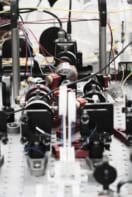
Physicists in the US have discovered yet another useful property of the wonder material graphene – it can function much like a laser when excited with very short femtosecond light pulses. The team has shown that the material has two technologically important properties – population inversion of electrons and optical gain. The findings suggest that graphene could be used to make a variety of optoelectronics devices, including broadband optical amplifiers, high-speed modulators, and absorbers for telecommunications and ultrafast lasers.
Graphene is a sheet of carbon atoms arranged in a honeycomb-like lattice just one atom thick. Since its discovery in 2004, the material has continued to amaze scientists with its growing list of unique electronic and mechanical properties. Graphene could find use in a number of technological applications – even replacing silicon as the electronics industry’s material of choice in the future thanks to the fact that electrons whizz through graphene at extremely high speeds, behaving like “Dirac” particles with no rest mass.
Ideal for photonics?
The material could also be an ideal candidate for photonics applications – especially optical communications, where speed is all-important. For example, it has an ideal “internal quantum efficiency” because almost every photon absorbed by graphene generates an electron–hole pair that could, in principle, be converted into electric current. Thanks to its Dirac electrons, it can also absorb light of any colour and responds extremely fast to light, which suggests that it could be used to create devices much faster than any employed in optical telecommunications today.
Researchers have already shown that they can make basic devices, such as solar cells, light emitters, touch screens and photodetectors from graphene. However, few studies have looked at what happens when the material is excited with femtosecond (fs) light pulses that create so-called non-equilibrium charge states – particularly the state consisting of extremely dense Dirac electrons. Materials that harbour such states have nonlinear optical properties that are important for making real-world optical devices, such as ultrafast modulators, amplifiers and wavelength converters.
Inversion and gain
In their experiments, Jigang Wang and colleagues at Ames Laboratory and Iowa State University excited high-quality, epitaxially grown graphene monolayers with pump laser pulses just 35 fs long and photon energy of around 1.55 eV. They then measured how much light was reflected by the samples. Because graphene is just one atom thick and has a zero-energy electronic bandgap, this measurement provides information on the amount of light absorbed by the material. This in turn depends on the optical conductivity of graphene, explains Wang.
The researchers found that the optical conductivity changes from being positive to negative as the intensity of the pump pulses increases. “This means that more light is coming out of the material than going in, something that indicates optical gain,” says Wang.
The team demonstrated that the intense external pump laser pulses excite electrons in graphene so that more of these charge carriers exist in the upper “Dirac cone” – the conduction band of the material – than in the lower cone. Once such a population inversion has occurred, a probe photon then stimulates these excited states to emit infrared light in a coherent cascade. “The coherent light emitted shows gain on the order of about 1%, a value that is much greater than those seen in conventional semiconductor optical amplifiers – a surprising result since graphene is merely one-atom thick,” says Wang.
A wide energy range
The team found that this optical gain could be observed over a wide range of energies – up to hundreds of millielectronvolts below the pump photon energy. Such a broad optical gain might be unique to graphene and related to the fact that photoexcited electrons in the material scatter extremely fast among themselves. What is more, an ultrashort pulse just 35 fs long is sufficient to produce this broadband gain – something that has never been seen before in any material.
The population inversion and resulting optical gain in the infrared part of the electromagnetic spectrum confirms graphene’s potential for applications such as broadband optical amplifiers, lasers and in telecommunications. However, there is still much to do before this happens, says Wang, who is now looking at further characterizing the photoexcited graphene states in the near-infrared to the mid- and far-infrared spectral regions. “We are also studying the effects of different sample configurations and growth methods,” he reveals.
The current work is reported in Phys. Rev. Lett. 108 167401.



